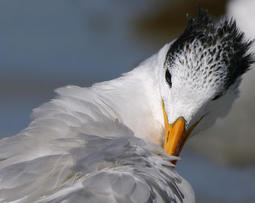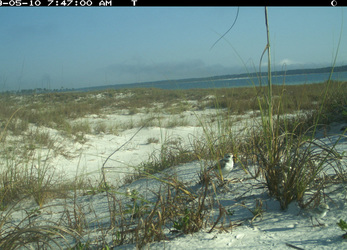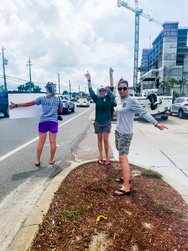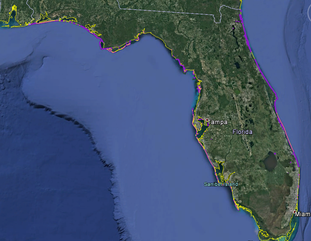Events
August 14: Breakfast with the Birds: Back from the Brink - Using Social Attraction to Save Seabirds. RSVP at Rookery Bay.
August 21: Annual Suncoast Shorebird Partnership volunteer party. RSVP to Holley Short.
Reminders:
August 5-11: The final count window for the Breeding Bird Protocol. If you're surveying a route with active nesting, weekly surveys help capture information about peak counts.
All Summer: Beach stewards are needed at important beach nesting sites. Check out the map of local stewardship opportunities and contact us to get involved!
 Be a Shorebird-friendly Photographer
The August issue of the Wrack Line features a cover photo of a gathering known as a seabird "crèche" - a group of chicks from different broods attended by a smaller number of adults, freeing other parents to forage. Happening upon a crèche can be exciting, and admirers are often eager to photograph the charismatic birds that take temporary residence on the beaches each year. However, photographing birds for our enjoyment should not come at the cost of their chronic disturbance. If you are one of the lucky people to encounter and photograph shorebirds, please remember how to be a shorebird-friendly photographer.
When photographing a bird on a nest:
Remain behind the posted area. No part of you or your camera equipment should go beyond the string or signs. If the area around the nest is not staked off, you should remain far enough away to avoid disturbing the birds (typically 300 feet). If the birds show any sign of agitation as a result of your presence, quietly and slowly retreat until the birds no longer appear disturbed.
Never get close enough to cause the bird to leave its nest. Back off immediately if you flush a bird. Sometimes birds nest near the edge of a posted boundary, so even if you are outside the string, if the bird responds to you, you’re too close!
Scan for predators. Make sure there are no predators nearby such as raccoons, cats, and crows that may be attracted to human presence or scent. Predators also are alert to movement, so by flushing a bird, you may inadvertently help predators notice birds that would otherwise have remained camouflaged.
Don’t exceed 10 minutes. Too much time near the nest may unduly stress the birds. Be considerate and do not spend more than 10 minutes near the nest.
If other photographers are present, try to coordinate your time near the nest, and leave the area together, so that the birds have at least three hours of undisturbed time.
Don’t specify the nest’s exact location when sharing or publishing photos. Advertising the birds’ nesting location may draw additional disturbance to the nest.
When photographing birds that are away from their nests, or birds with chicks:
Stay at least 100 ft away from the birds. Wait for the birds to approach you for closer shots.
Don’t “push” the birds around the beach. Birds need to be able to feed and rest without disturbance. Shorebird chicks must constantly forage to gain enough weight to fledge in time, so any time taken away from foraging can be harmful to their health and survival.
For more tips, read "How to Be a Shorebird-friendly Photographer"
(Royal tern photo by Alex Kropp)
|
 Game Cameras: An effective tool to boost shorebird nesting success
As part of the Breeding Bird Protocol, each season Florida Shorebird Alliance partners monitor nesting sites and determine nesting outcomes. Even with repeat visits, if a nest fails partners are often left wondering what happened, and the uncertainty creates challenges for site management. To improve our knowledge of nesting outcomes and maximize adaptive management strategies, FWC, Audubon Florida and partners throughout the state are using game cameras as a supplemental tool for monitoring.
When tracks are observed at a sandy, vacant nest site, it may seem straightforward to determine the source of the nest loss. However, not all nests are on a sandy beach and not all predators leave tracks or other evidence of their presence. Often, the weather (rain or wind) erases most evidence. Also, sand tracking is frequently biased towards larger mammalian predators, whose tracks do not easily disappear with the weather. Potential avian predators such as fish crow or light weight predators such as snakes leave very little evidence at nest sites and can be easily overlooked.
Game cameras are one tool that can be used to collect information on nest outcomes and identify sources of nest loss. The information collected using game cameras can be critical to inform site specific management actions to improve shorebird nesting productivity. For example, with the use of game cameras at St. George Island State Park, it was discovered that American oystercatchers were often off their nest for hours at a time when kayakers moored nearby. Using this information, Audubon Florida developed targeted outreach messages, including improved maps that state park staff now provide to kayakers, so they can avoid paddling near sensitive nesting areas in the park.
The same park typically supports 30-40 breeding snowy plover adults. Despite the high number of adults, over the last five years only one chick, on average, has fledged per season. To determine the cause of low productivity, game cameras were installed at strategic areas. The cameras documented a wide diversity of nest, chick and adult predators that include, but are not limited to: coyote, opossum, gray fox, raccoon, ghost crab, laughing gull, fish crow, snakes, and great horned owl. The predator evidence provided critical information to determine management actions that could best benefit nesting shorebirds at the park. In response, an adaptive predator management program was implemented focusing on the most frequent predators. As a result, shorebird biologists are documenting higher nesting success and fledgling rates at the park this breeding season. So far in 2018, six snowy plovers have successfully fledged and two more are close to being flight capable!
There are many types of game cameras available and various settings that can be implemented. The type and settings will depend on the overall conservation question of interest. Strategies vary from using motion sensors to recording photos every 30 seconds, while ensuring the camera is camouflaged to minimize detection by predators. Regardless of camera type and settings, you must be prepared to look through hundreds, possibly thousands of photos.
The information collected using game cameras is proving to be effective at guiding management and conservation efforts for shorebirds in Florida and throughout their range. Because of the success of using game cameras as a diagnostic tool, FWC is currently drafting a guidance document on using them to implement adaptive management strategies. Stay tuned for more information on this guidance document.
|
 Carwash for the Birds a Big Success!
A fantastic partnership with a popular Panama City beach hotel came to life recently. The Chateau by the Sea, a member of the By The Sea Resorts family, hosted the first “Carwash for the Birds” with big support from Audubon and Florida and Florida Fish and Wildlife Conservation Commission (FWC). The goal of the carwash was highlight the unique position this hotel has in hosting over 250 least terns nesting and raising their chicks on the flat gravel rooftop. This colony is the largest rooftop colony of least terns in the Florida Panhandle and with this number of birds comes a great deal of mess! Audubon Florida and FWC wanted to find a way to say thank you to Chateau by the Sea for being such great hosts and protectors of these imperiled seabirds so they offered to clean the mess off hotel patrons’ vehicles.
Audubon, FWC, and a group of dedicated volunteers showed up to brave the Florida summer heat and wash cars not just for the hotel's guests but for any that stopped by for a cleanup. The large amount of street traffic helped get a steady stream of cars coming through to enjoy a free carwash as well as learn about the nesting shorebirds. The carwash raised donations to go toward Audubon's Coastal Bird Stewardship Program and raised awareness about the protected birds nesting on our beaches. Plans are already in the works to have a bigger and better event for next summer, so stay tuned!
Due to high levels of beach recreation, development and predator pressures, nesting on the beach is challenging for the small least tern. Gravel rooftops offer an alternative habitat for the least terns to be successful in raising their chicks. Success at sites like the Chateau By the Sea largely depends on the willingness and cooperation of the building owners and staff to help protect the nesting birds. From all of us here the Florida Shorebird Alliance THANK YOU to Chateau by the Sea and our other business owners that go above and beyond for their feathered rooftop guests each year!
|

 There’s a new way to explore data in the FSD!
Have you ever wanted to look at a map of all the sites partners have been monitoring during the current breeding season? Well, now you can! The latest feature in the FSD allows you to download the different site types in KML format – that means you can open them in Google Earth!
Here’s how you can download the data:
1. Log in to the FSD
2. Click on the Explore Data tab
3. In the Search and Export box, click on the Data Summary button
4. In the Public Data box, click on whichever site type you want to download
Voilà! Now you can explore this year’s data in Google Earth! As always, if you have any questions, email FLShorebirdDatabase@myFWC.com.
|
Reminder!
August 5th - 11th is the final Count Window of Florida’s statewide breeding shorebird and seabird survey. This window focuses on counting chicks and fledglings that were produced this season. Although this is the last Count Window of the 2018 breeding bird protocol, we highly encourage you to continue weekly surveys as long as chicks and nesting birds are observed in your area.
Shorebird Resources:
Having a shorebird festival? Let everyone know at shorebirdfestivals.com
Are you recording chicks on your routes and rooftops surveys? Keep your skills up-to-date with Chick Aging Guides
Found an injured seabird? Download the Seabird Rehabilitator and Transporter App for Apple and Android
Shorebirds in the News:
Piping Plovers Want People to Get Off Their Lawn
Red Knots Plummet by 25% in a Year in Tierra del Fuego
Late Snowpack Signals a Lost Summer for Greenland’s Shorebirds
|